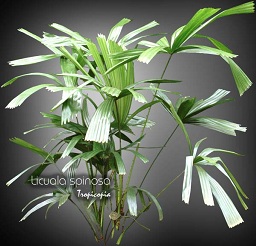Table of contents
Spiny licuala palm

Latin Name: Licuala spinosa
Category: Palm
Family: Arecaceae
Origin: Malaysia
Climate: Tropical
Growing Zones: 11-10
Care Instructions
The Spiny licuala palm (Licuala spinosa) is a tropical plant that originates from Malaysia. This palm plant belongs to the Arecaceae family and is well-suited for growing in USDA zones 11-10.
Complete Care Guide for Spiny Licuala Palm (Licuala spinosa)
Watering Requirements
The Spiny Licuala Palm thrives in consistently moist soil, making proper watering essential for its health. It is important to keep the soil evenly moist but not soggy. Water the plant thoroughly when the top inch of soil feels dry to the touch. During the growing season, which typically spans from spring to early fall, the palm may require more frequent watering, especially in warmer climates. In winter, reduce watering slightly, allowing the soil to dry out a bit more between waterings. Always ensure that the pot has good drainage to prevent root rot, which can be detrimental to the plant’s health.
Light Conditions
The Spiny Licuala Palm prefers bright, indirect light but can also tolerate partial shade. Direct sunlight can scorch its leaves, so it is best to place it in a location where it receives filtered light, such as near a window with sheer curtains or in a well-lit room. If grown outdoors, consider placing it in a spot that receives dappled sunlight or morning sun with afternoon shade. Insufficient light can lead to leggy growth and a decline in overall health, so ensure it gets adequate light for optimal growth.
Soil Preferences
The ideal soil for the Spiny Licuala Palm is a well-draining potting mix that retains moisture without becoming waterlogged. A mixture of peat, pine bark, and perlite or sand can provide the right balance of drainage and moisture retention. It is also beneficial to incorporate organic matter, such as compost, to enhance soil fertility. Fertilization should be done during the growing season with a balanced, water-soluble fertilizer every 4-6 weeks to promote healthy growth. In the winter months, reduce fertilization as the plant enters a dormant phase.
Pests and Diseases
The Spiny Licuala Palm can be susceptible to common pests such as spider mites, mealybugs, and scale insects. Regularly inspect the leaves for signs of infestation, such as webbing or sticky residue. If pests are detected, treat them promptly with insecticidal soap or neem oil, ensuring to cover both the tops and undersides of the leaves. Additionally, the plant can be prone to fungal diseases if overwatered or if humidity levels are too high. To prevent these issues, ensure proper air circulation around the plant and avoid wetting the leaves during watering. If fungal infections occur, remove affected leaves and apply a fungicide as needed.
Special Care Tips
To maintain the health and beauty of your Spiny Licuala Palm, consider the following special care tips: First, regularly dust the leaves with a damp cloth to keep them clean and allow for optimal photosynthesis. This also helps prevent pest infestations. Second, maintain a humid environment, as this palm thrives in higher humidity levels. You can achieve this by misting the leaves or placing a humidifier nearby. Third, avoid placing the palm near heating vents or air conditioning units, as sudden temperature changes can stress the plant. Lastly, repot the palm every couple of years to refresh the soil and provide more space for growth, ensuring that the new pot is only slightly larger than the previous one to prevent overwatering issues.








